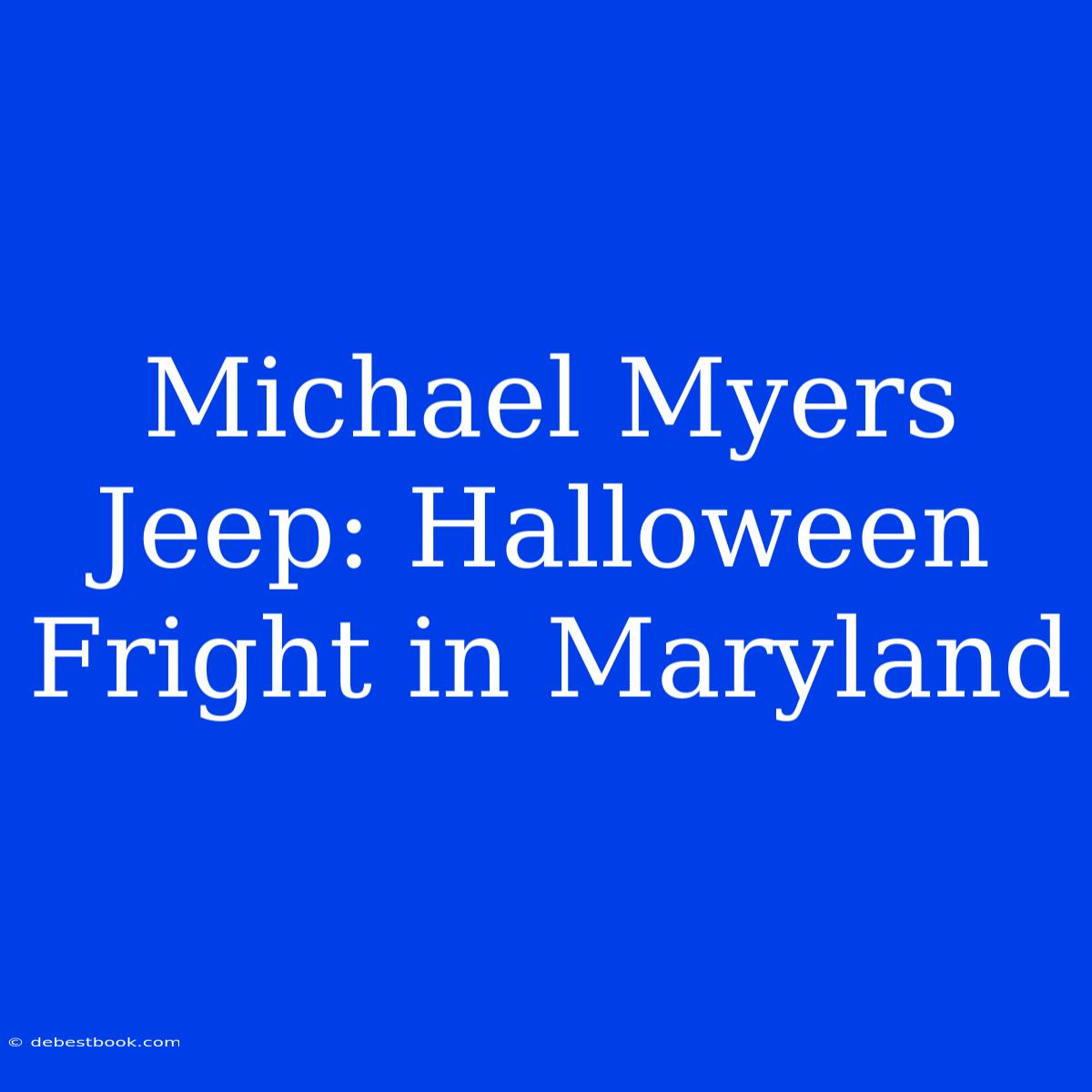Michael Myers Jeep: Halloween Fright in Maryland
Do you ever wonder what kind of vehicle Michael Myers would drive? A chilling sight has been reported in Maryland, a Jeep Wrangler thought to be driven by the iconic horror villain himself. This chilling tale has captivated the imaginations of horror fans and sparked curiosity about the connection between the vehicle and the iconic killer.
Editor Note: The Michael Myers Jeep has been making headlines, and there are plenty of reasons why this story is so intriguing. Not only does it tie into the beloved Halloween franchise, but it also raises questions about the psychology of fandom and the cultural impact of horror. This article will explore the details surrounding this strange sighting, delve into the connection between Michael Myers and Jeeps, and examine the broader implications of this story.
To understand the phenomenon, it's crucial to look into the history of the Jeep brand. Jeep Wranglers have become synonymous with adventure and off-roading, often associated with a rugged, independent, and sometimes rebellious spirit. This image resonates with Michael Myers's nature, his relentless pursuit of his victims, and his detached, emotionless personality. Could this explain the choice of vehicle?
In our analysis, we dug into online forums, news articles, and social media posts about the Maryland sighting. We also researched the history of the Jeep brand and its association with pop culture. Our goal was to create a comprehensive guide that explores the connection between the Jeep Wrangler and Michael Myers, revealing the cultural impact of this seemingly simple observation.
Here are the key takeaways of our exploration:
| Key Aspects | Description |
|---|---|
| The Jeep Wrangler's Popularity | This vehicle has become a cultural icon, often appearing in movies and TV shows. |
| Michael Myers's Symbolism | The villain's image is often associated with darkness, silence, and relentless pursuit. |
| The Jeep Wrangler's Association with Freedom | This vehicle's off-road capabilities offer a sense of escape and freedom, echoing Michael Myers's pursuit of his own path. |
| The Impact of Horror Fandom | Fans often express their love for horror through costumes, decorations, and even their choice of vehicles. |
The Jeep Wrangler's Association with Horror
The Jeep Wrangler is more than just a vehicle; it's a symbol of freedom and a way to break free from societal norms. This resonates with Michael Myers's character. While he may not be driven by a desire for freedom, his actions reflect a desire to operate outside of conventional boundaries. The Jeep Wrangler's iconic design, combined with its ruggedness and off-road capabilities, might symbolize this desire for autonomy and unfettered pursuit.
Michael Myers & the Jeep Wrangler
The Jeep Wrangler's association with the Halloween franchise is not just a product of popular imagination. Several Jeep Wrangler models have been featured in the Halloween films themselves, including the 1978 original, which depicts a dark, intimidating Jeep driving through the night. The association between Michael Myers and the Jeep Wrangler is not solely based on a shared aesthetic but has been cultivated through the franchise's history.
The Impact of Fandom
The Michael Myers Jeep sighting is not just about a vehicle; it's about the power of fandom. Horror enthusiasts often use their passions as avenues for self-expression. This can manifest through costumes, decorations, and even vehicle choices. The desire to connect with a beloved character or franchise can take various forms, and this sighting highlights the creative ways fans connect with their favorite horror icons.
FAQs about the Michael Myers Jeep
Q: Is there any official connection between Michael Myers and the Jeep Wrangler?
A: While the Jeep Wrangler has been featured in the Halloween franchise, there is no official confirmation that the Maryland sighting was connected to the films or any related production.
Q: Is the sighting real or a hoax?
A: The authenticity of the sighting remains unverified. However, the story has captured the attention of many, sparking discussions about the connection between the Jeep Wrangler and Michael Myers.
Q: What are the ethical implications of this sighting?
A: The sighting raises questions about the boundaries of fandom, the potential for misuse of iconic imagery, and the impact of horror on popular culture.
Q: Is it okay to use iconic imagery from horror films for personal use?
A: It's important to consider the context and impact of using iconic imagery from horror films. While many people use such imagery for fun and self-expression, it's crucial to do so responsibly and avoid causing distress or harm.
Tips for Avoiding Horror-Themed Misunderstandings
-
Respect the Boundaries of Fandom: While expressing passion for horror is encouraged, it's important to avoid causing fear or distress to others.
-
Understand the Power of Imagery: Be mindful of the potential impact of using iconic imagery from horror films, especially in public spaces.
-
Be Transparent: If you're using a horror-themed vehicle or costume, consider sharing the context with others, explaining that it's an expression of fandom.
-
Be Aware of Your Surroundings: Consider the time and place when displaying horror-themed imagery, especially in areas where people might feel unsafe or uncomfortable.
-
Practice Respect and Consideration: Engage with other fans in a respectful way, acknowledging that not everyone may share the same level of enthusiasm for horror.
Summary of the Michael Myers Jeep Phenomenon
The Michael Myers Jeep sighting highlights the unique way fandom connects with popular culture. It encourages us to think about the role of iconic imagery, the power of personal expression, and the potential for both positive and negative implications when combining our passions with public displays. Whether the sighting was a genuine tribute to the iconic villain or simply a clever publicity stunt, it has ignited a conversation about the intersection of horror, fandom, and pop culture. This phenomenon reminds us that the boundaries of fandom are constantly shifting, and the interpretation of iconic imagery can be subjective and often unexpected.

